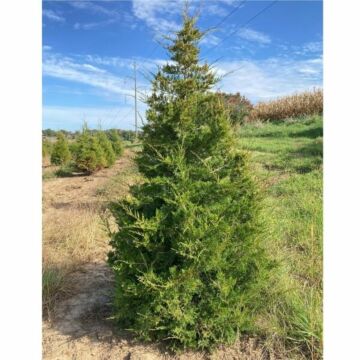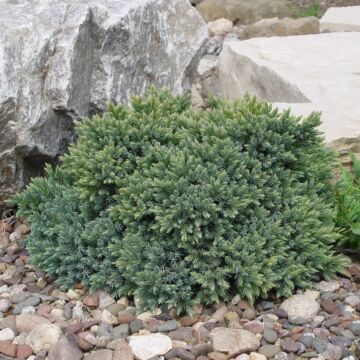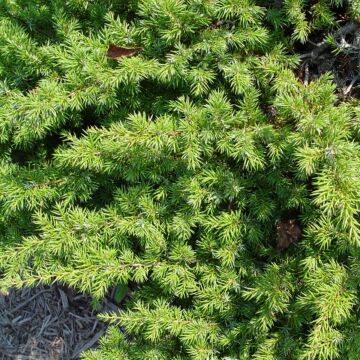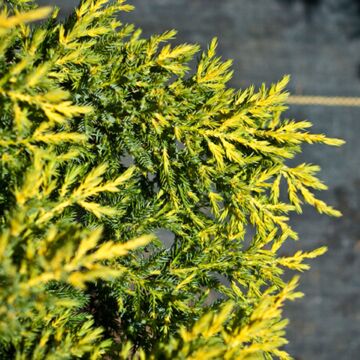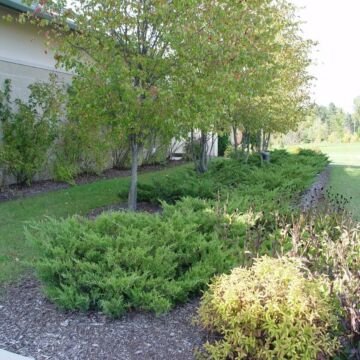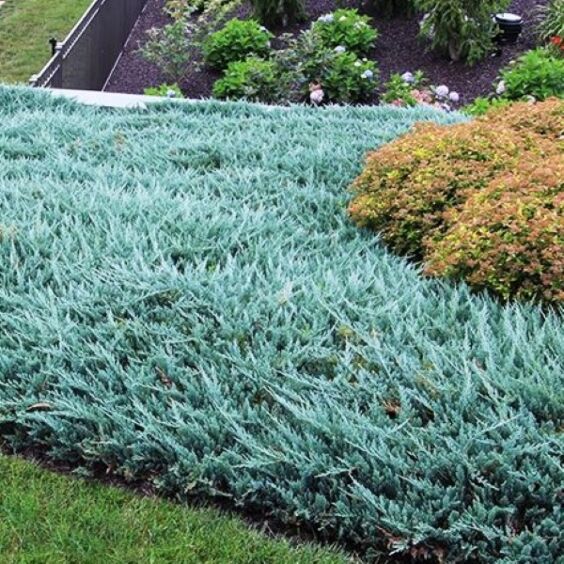
Growing zones
See Zone Map >Status: In stock
The attractive, rich color of its silver-blue foliage makes a stunning contrast against other plants in your landscape. Besides its dashing good looks, it’s incredibly durable, making it an excellent choice for any climate.
This hardy shrub is particularly well-suited to cold regions and can easily withstand snow and freezing temperatures. It's also adaptable to extreme temperatures, perfect for fluctuating day and night temperatures in desert environments.
Blue Chip Juniper is a versatile plant used in several landscaping situations. It functions similarly to groundcover junipers and spreading junipers that are great for edging driveways or covering weed areas. Its low-growing habit and tolerance to harsh conditions make it ideal for rock gardens and Zen gardens, where it can provide a calming, natural atmosphere. It's also an excellent choice for erosion control on slopes and hillsides or as foundation plantings to cover weeds or gravel.
- Sun
Mature Plant Size (H x W): .5-1' x 6-8'
- Attracts Birds
- Deer Resistant
- Drought Tolerant
- Winter Interest
- Stone Mulch
- Walnut Toxicity Resistant
- Cut Flower
Planting & Care for Blue Chip Juniper
Preparation
- Blue Chip Juniper is low maintenance, hardy, and will prevent weeds with its thick growth!
- This plant can resist droughts but will struggle if planted in wet soils or sandy soils.
- Space about 5 feet apart when planting.
- No pruning is required unless the growth needs to be contained to an area. If needed, trim in early spring.
- Blue Chip Juniper will not handle foot traffic; the branches will break and die back.
Opening Plant Material
- Containers: Completely saturate all container plants by putting them in a larger water container until bubbling stops. Remove the plant, then dig a hole no deeper than the depth of the container, ensuring it’s wider on the sides by an additional 6” or more.
Planting Containers
- Dig a hole no deeper than the depth of the container and 6" or wider on the sides.
- Slide the plant from the pot by tapping on the bottom of the pot.
- With a shovel or knife, trim the bottom 2" off the root ball for plants in plastic containers.
- Rotate the plant to the proper position. Never lift or move plants by the tops.
Place the root ball in the hole. - Adjust the plant height so the root crown is slightly higher than the ground.
- Notice where the base of the trunk flares out from the tree. This is called the root flare. This root flare should show when the tree is planted. Add soil under the ball so the root flare is exposed if necessary.
- Place fertilizer packets into the bottom of the hole (if purchased). *Use Our Recommended Fertilizer.
- Backfill the hole with soil, ensuring the top of the root ball is visible and slightly higher than the soil around it.
- Firm the soil around the plant. Water well to settle soil around the root ball.
Pruning - After Planting
- Containers: Although it’s not essential after planting, light pruning can help with a Blue Chip Juniper’s shape. Doing so removes any broken branches from shipping or thins out a heavily branched plant to help in the transplanting process and the appearance of your new planting.
Pruning - Throughout the Season
- Watch our helpful pruning videos on our “Plant Features & Videos” tab to be sure you’re pruning your juniper correctly and at the right time of year.
Watering - After Planting
- Plants typically take approximately 6 weeks to establish new roots in your soil. During this period, water plants as often as every 2-4 days at the start and at least a minimum of once per week.
- Beyond the 6-week establishment period, water once per week unless rain occurs.
- Remember to check soil moisture by sticking your finger into the soil around 3”.
Watering - Through-out the Season
- After the first season, plants should only be watered during extended periods without rain.
- How do you know if your plants need water? The easiest way to tell is to touch the soil around the roots. If it’s moist, there is no need to water. If it’s dry, give it a good soak with the hose end (no nozzle), watering the soil only, not the leaves.
- Same as after planting, stick your finger into the soil around 3” to check soil moisture.
Frequently Asked Questions
What are some ideal companion plants for Blue Chip Juniper in a garden setting?
Blue Chip Juniper pairs well with various garden plants with similar growing conditions. Some examples include Barberry, Daylilies, and Sedum, which are all available at McKay Nursery’s catalog. These plants complement the Blue Chip Juniper with their contrasting textures and colors, enhancing the overall visual appeal of your garden.
Does a low-growing Juniper require regular fertilization?
A low-growing Juniper does not require regular fertilization. It thrives in well-draining soil and is relatively easy to grow. For optimal growth and health, you can apply a balanced, slow-release fertilizer formulated for evergreens in early spring, which helps the plant establish robust roots and lush foliage.
How do I prune a low-growing Juniper?
Pruning a Blue Chip Juniper is generally done to maintain its shape or remove damaged branches. It's best to prune in late winter or early spring before new growth starts. Use sharp, clean pruning shears to make clean cuts. Removing dead or overlapping branches regularly can also help improve air circulation and light penetration within the plant.
What common pests and diseases affect Blue Chip Junipers?
Blue Chip Junipers are hardy and relatively resistant to pests and diseases. However, they can occasionally be affected by spider mites and juniper scale. Fungal diseases like cedar-apple rust might also occur, especially in humid conditions. Regular monitoring and maintaining good air circulation around the plants can help prevent these issues.
Can the Blue Chip Juniper be used as a ground cover?
Like its cousins (e.g., Blue Pacific Juniper, Creeping Juniper, and Chinese Juniper), a Blue Chip Juniper can effectively be used as a ground cover. This is due to its low-growing, spreading habit. It provides excellent coverage for slopes or rocky areas, helping control erosion while adding texture and color to the landscape. Its dense foliage suppresses weeds, and its hardy nature requires minimal upkeep once established.
Upgrade Your Landscaping With McKay Nursery
At McKay Nursery, we leverage our century-long expertise in the horticulture industry to offer an exquisite selection of plants, including the versatile Blue Chip Juniper. Located in the heart of Waterloo, Wisconsin, our nursery dedicates itself to nurturing hardy, vibrant plants for your particular needs.
Order your low-growing Junipers today! For expert guidance or additional support, contact us at [email protected] or 920-478-2121.
Planting & Handling Help
Download our Planting and Handling Guide below to plan for a successful arrival and install of your plants. Be sure to water all plants as soon as they arrive and every day until you’re ready to plant. Keep any bare root bundles in a shady, cool spot with the roots covered at all times.


Learn More
Watch our videos on handling bare root plants, how your order is prepared for shipment and more.
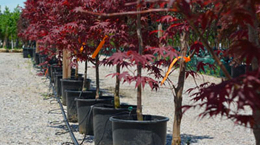

Plant Sizing
What is the difference between Containers, Grow Bags, Bare Root, and Balled & Burlap (B&B)?
Shipping Times
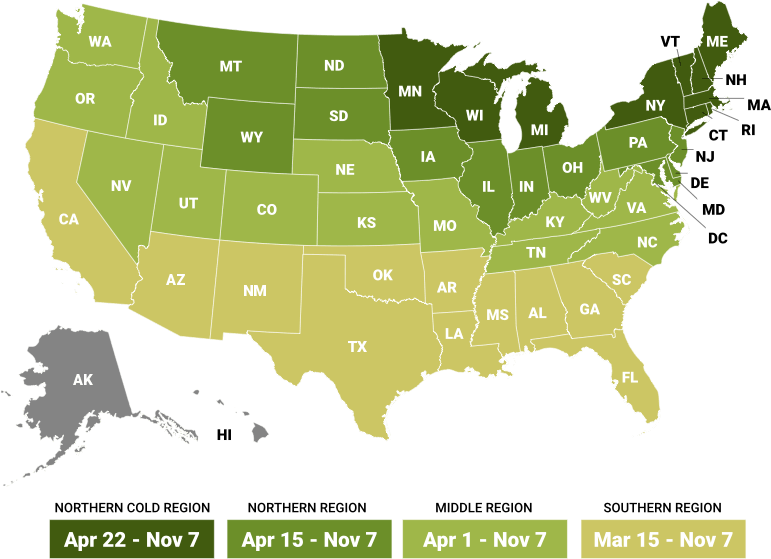

Our FedEx and local shipping times depend on two factors, one is by the region and the second is the type of product being shipped. For example, small fruits are only shipped in spring, but majority of our perennials are shipped from spring until fall. Keep in mind the dates below act as a general guide. Due to unpredictable weather, staffing, inventory and industry demands these timelines can change. Therefore, we cannot guarantee any of these times.
Shipping Dates by Region*
Northern Cold Region: April 22nd - November 7th
Northern Region: April 15th - November 7th
Middle Region: April 1st - November 7th
Southern Region: March 15th - November 7th
Local Delivery (small radius from Waterloo, WI): April 22nd - November 7th
Shipping Dates by Season*
Spring Shipping: Region Start Date (above) - May
Fall Shipping: September - November
Due to unpredictable weather, these times may vary. Some varieties are exceptions due to heat and plant health reasons. Enter your shipping zip code at the top of this page and be sure to check the shipping information on each product before you add it to your cart. If the product is too large or restricted in your state, you will not be able to checkout with that item in your cart.

